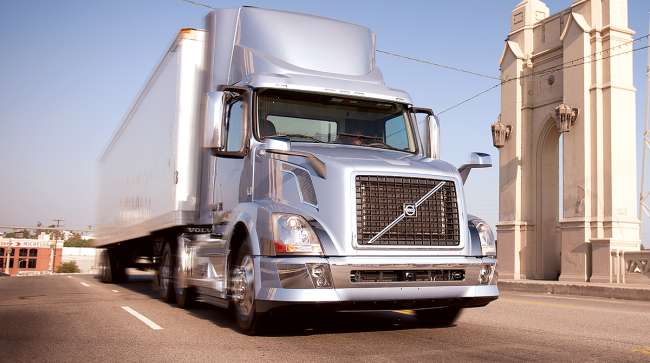Senior Reporter
Volvo Rides Higher Truck Revenue to First-Quarter Gains

AB Volvo reported first-quarter net income and revenue rose as it brought in more money from truck sales in all markets.
For the period that ended March 31, Volvo — which reports in Swedish krona — had net income that was the approximate equivalent of $1.1 billion, or 56 cents per diluted share, compared with $620 million, or 30 cents, a year earlier.
Revenue increased 20% to $11.4 billion compared with $9.5 billion a year earlier.

The company’s operating margin increased to 13.2% compared with 9.3% a year earlier.
The Gothenburg, Sweden-based company is the world’s second-largest commercial vehicle manufacturer.
Its global truck revenue rose 22% to $7.25 billion compared with $5.7 billion in the 2018 period.
Truck revenue in Europe was the highest, climbing 7% to $2.9 billion. North American truck revenue totaled $2.45 billion, a 50% increase compared with a year earlier. Truck revenue in South America, Asia, and Africa and Oceania also rose.
“Both our vehicle and service business grew at a good pace. The increased sales volumes together with an improvement in our operational performance contributed to a rise in profitability,” Volvo CEO Martin Lundstedt said in a company release.
Deliveries were strong.

Lunstedt
In the quarter, Volvo delivered 14% more trucks overall compared with a year earlier — 58,594 compared with 51,574 — when its North American production had capacity constraints connected to the changeover to new trucks at Volvo Trucks North America and Mack Trucks, its North American brands.
Mack’s deliveries increased 54% to 7,621 compared with 4,960 in the 2018 quarter. VTNA’s deliveries climbed to 9,584 compared with 7,166 a year earlier.
Volvo also is the parent company of truck brands Renault and UD. Deliveries in South America rose 47% to 4,734. Asian deliveries slipped 5% to 6,688. Deliveries to Africa and Oceania were flat at 3,083.
Orders were not strong. Total truck orders in the quarter dropped 36% to 45,884 compared with 71,965 a year earlier, primarily because of North America, as its order books there are close to full for 2019, Lundstedt said.
North American orders plummeted by 77% to 5,469 vehicles compared with 23,405 a year earlier. Mack’s orders fell 67% to 3,243 compared with 9,952 a year earlier. VTNA posted 2,226 orders in the quarter, down from 13,453 a year earlier.
“We are not worried about a fast-pace slowdown of the North American order intake as long as the order book situation is as solid as it is,” Pareto analysts Erik Paulsson and Anders Roslund said in a note, Bloomberg News reported, adding that Volvo shares have gained 37% since the start of the year.
Volvo also noted North America dealers have weeded out orders they felt were not secure and that affected order intake.
During a conference call when asked about opening the order book for 2020, Lundstedt said, Volvo would open it rather cautiously, “so we have healthy pressure in the whole downstream value chain when it comes to inventory levels.”
Although it is early in the year, for certain large deals, the 2020 order book is open, he added.
“It could be fleets, where it is important for our customers to feel [their order] is placed according to their wishes. We are not stubborn,” he said.
He added that parts shortages at the beginning of the quarter had “quite a few trucks standing” awaiting completion.
That situation gradually resolved from mid-February on, he said. “We had very strong deliveries in March.”
Meanwhile, VTNA’s North American market share fell in the quarter to 9%, down from 10.2%, and Mack's share declined to 5.5% compared with 6.5% a year earlier. The company kept its industry forecast for North American Class 8 retail sales at 310,000.
“With an encouraging start to the year, we also continue our work to strengthen our customers’ and the Volvo Group’s competitiveness. It is a continuous journey where we are focusing on improving quality, on growing our service business by working even closer with our customers and on increasing efficiency in all parts of the Group and throughout the supply chain,” Lundstedt said.




